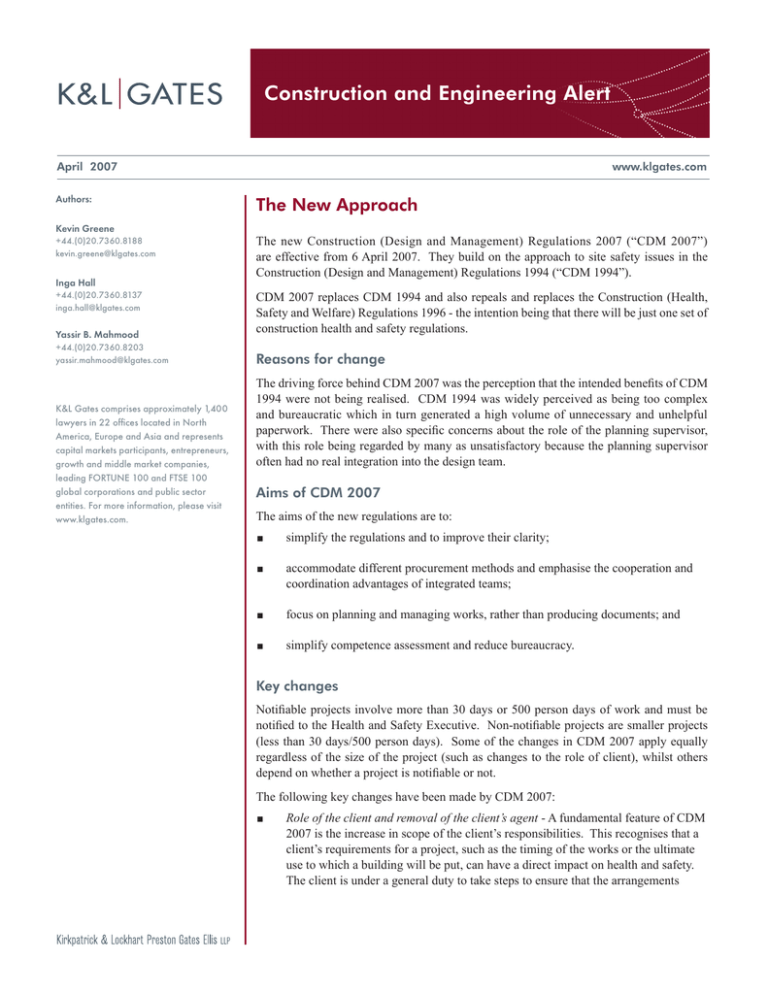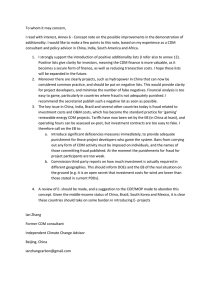
Construction and Engineering Alert
April 2007
Authors:
Kevin Greene
+44.(0)20.7360.8188
kevin.greene@klgates.com
Inga Hall
www.klgates.com
The New Approach
The new Construction (Design and Management) Regulations 2007 (“CDM 2007”)
are effective from 6 April 2007. They build on the approach to site safety issues in the
Construction (Design and Management) Regulations 1994 (“CDM 1994”).
Yassir B. Mahmood
CDM 2007 replaces CDM 1994 and also repeals and replaces the Construction (Health,
Safety and Welfare) Regulations 1996 - the intention being that there will be just one set of
construction health and safety regulations.
+44.(0)20.7360.8203
yassir.mahmood@klgates.com
Reasons for change
+44.(0)20.7360.8137
inga.hall@klgates.com
K&L Gates comprises approximately 1,400
lawyers in 22 offices located in North
America, Europe and Asia and represents
capital markets participants, entrepreneurs,
growth and middle market companies,
leading FORTUNE 100 and FTSE 100
global corporations and public sector
entities. For more information, please visit
www.klgates.com.
The driving force behind CDM 2007 was the perception that the intended benefits of CDM
1994 were not being realised. CDM 1994 was widely perceived as being too complex
and bureaucratic which in turn generated a high volume of unnecessary and unhelpful
paperwork. There were also specific concerns about the role of the planning supervisor,
with this role being regarded by many as unsatisfactory because the planning supervisor
often had no real integration into the design team.
Aims of CDM 2007
The aims of the new regulations are to:
n
n
simplify the regulations and to improve their clarity;
accommodate different procurement methods and emphasise the cooperation and
coordination advantages of integrated teams;
n
focus on planning and managing works, rather than producing documents; and
n
simplify competence assessment and reduce bureaucracy.
Key changes
Notifiable projects involve more than 30 days or 500 person days of work and must be
notified to the Health and Safety Executive. Non-notifiable projects are smaller projects
(less than 30 days/500 person days). Some of the changes in CDM 2007 apply equally
regardless of the size of the project (such as changes to the role of client), whilst others
depend on whether a project is notifiable or not.
The following key changes have been made by CDM 2007:
n
Role of the client and removal of the client’s agent - A fundamental feature of CDM
2007 is the increase in scope of the client’s responsibilities. This recognises that a
client’s requirements for a project, such as the timing of the works or the ultimate
use to which a building will be put, can have a direct impact on health and safety.
The client is under a general duty to take steps to ensure that the arrangements
Construction and Engineering Alert
made for the management of the project are
suitable to enable the construction works
to be carried out safely. The ability under
CDM 1994 to “step down” the obligations of
a client to a client’s agent goes under CDM
2007. However, if there are a number of
clients involved in a project, they can agree to
nominate one of them as the sole client.
n
n
n
CDM co-ordinator - the role of planning
supervisor is replaced with the role of
CDM co-ordinator. The CDM co-ordinator
is the client’s key project advisor. He
must be competent, and has a key role to
play in assessing the competency of other
dutyholderduty-holders (designers, principal
contractors or contractors). The CDM coordinator is responsible for notifying the HSE
of notifiable projects and he must be appointed
by the client as soon as practicable after
the initial design work or other preparation
for construction work has begun. Until a
CDM co-ordinator and principal contractor
are appointed the client is deemed to take
responsibility for their roles. There is no
obligation to appoint a CDM co-ordinator on
non-notifiable projects.
Pre-Construction Information Pack - CDM
2007 introduces a new requirement for clients
to provide designers and contractors who may
bid for work with a pre-construction health
and safety pack, which replaces the old pretender health and safety plan. The difference
from CDM 1994 is a practical one - clients
must identify and assemble the relevant
information at a very early stage of the project.
Clients supply this information to the CDM
co-ordinator on notifiable projects and it is
then up to the CDM co-ordinator to check the
information to ensure that it is complete, and
pass it on to designers and contractors.
Competency and cooperation requirements
- no person is to appoint a dutyholder unless
he has taken reasonable steps to ensure that
such a person is competent, and no person
is to accept such an appointment unless
they are competent. Practically speaking,
assessing “competence” will mean assessing
a company’s organisation and arrangements
for health and safety and then assessing its
experience and track record to establish
whether it is capable of actually doing the
work.
n
n
Changes to the role of principal contractor clients must appoint competent and adequately
resourced principal contractors on all notifiable
projects. CDM 2007 emphasises the need
for early appointment in order to allow the
principal contractor to contribute to the design
phase, but otherwise the obligations are similar
to those contained in CDM 1994. Construction
work cannot start until a suitable construction
phase health and safety plan has been prepared
by the principal contractor. He must then
implement the plan and keep it updated.
Changes to the role of designer - the role of
designer is wider in CDM 2007 than in CDM
1994 as it now includes any person who
prepares or modifies the design or arranges and
instructs a person under his control to do so. A
designer could therefore be the client or any
other dutyholderduty-holder.
Like CDM 1994, CDM 2007 is accompanied by an
Approved Code of Practice (“ACoP”), which gives
practical guidance to accompany the legal rules set out
in the regulations themselves. The intention is that if
you follow the advice in the ACoP, you will be doing
enough to comply with the law in respect of those
specific matters on which it gives advice. As such,
deviations from the procedures and policies included
in the ACoP will need to be carefully considered.
Practical matters
Certain transitional arrangements apply as CDM 2007
applies to existing as well as new projects. Where
a project was ongoing before CDM 2007 came into
force (so that the deadlines for appointing a CDM
co-ordinator and principal contractor under the new
regulations have already been missed) then the client
must appoint them as soon as practicable. Dutyholders
appointed under CDM 1994 can be re-appointed under
CDM 2007, provided that the client ascertains the
appointees’ competence within 12 months. A client’s
April 2007 | 2
Construction and Engineering Alert
agent appointed under CDM 1994 can continue in
such a role for 5 years or until the end of the project
(whichever is earlier) subject to him agreeing to do
so.
If you are potentially a dutyholderduty-holder you
need to familiarise yourself with the new regulations
and consider how the transitional arrangements will
affect you. You need to ensure you understand the new
competency requirements and you should be updating
your in-house documents and standard forms to refer
to CDM 2007. You need to consider what will be done
in terms of producing pre-construction information
packs and pre-construction plans, and take account of
this in planning the timing of your projects so that the
procedures for producing the information are put in
train in good time.
All clients under CDM 2007 should ensure that they
plan works so that the arrangements and timescales
they impose allow for proper consideration of health
and safety issues. All clients need to be aware of
the need to provide pre-construction information and
ensure arrangements are in place for this information
to be procured promptly.
K&L Gates comprises multiple affiliated partnerships: a limited liability partnership with the full name Kirkpatrick & Lockhart Preston Gates Ellis LLP qualified
in Delaware and maintaining offices throughout the U.S., in Berlin, and in Beijing (Kirkpatrick & Lockhart Preston Gates Ellis LLP Beijing Representative
Office); a limited liability partnership (also named Kirkpatrick & Lockhart Preston Gates Ellis LLP) incorporated in England and maintaining our London
office; a Taiwan general partnership (Kirkpatrick & Lockhart Preston Gates Ellis) which practices from our Taipei office; and a Hong Kong general
partnership (Kirkpatrick & Lockhart Preston Gates Ellis, Solicitors) which practices from our Hong Kong office. K&L Gates maintains appropriate registrations
in the jurisdictions in which its offices are located. A list of the partners in each entity is available for inspection at any K&L Gates office.
This publication/newsletter is for informational purposes and does not contain or convey legal advice. The information herein should not be used or relied
upon in regard to any particular facts or circumstances without first consulting a lawyer.
Data Protection Act 1998—We may contact you from time to time with information on Kirkpatrick & Lockhart Preston Gates Ellis LLP seminars and with our
regular newsletters, which may be of interest to you. We will not provide your details to any third parties. Please e-mail london@klgates.com if you would
prefer not to receive this information.
©1996-2007 Kirkpatrick & Lockhart Preston Gates Ellis LLP. All Rights Reserved.
April 2007 | 3



